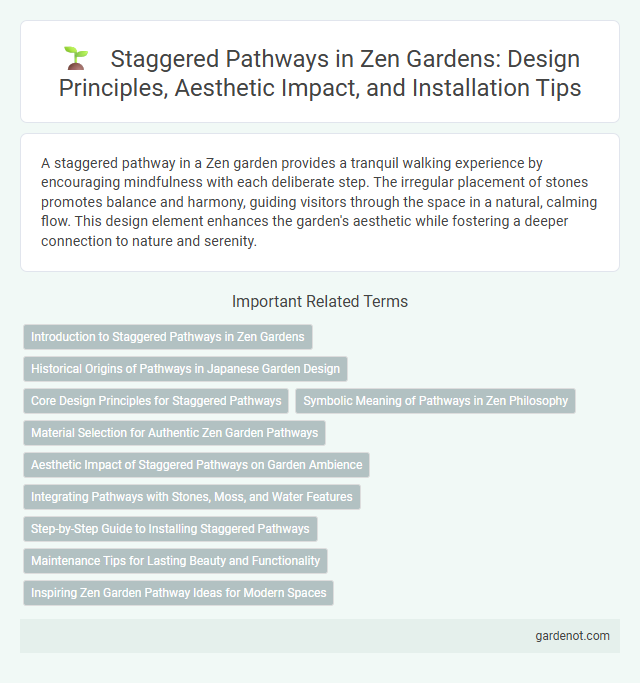A staggered pathway in a Zen garden provides a tranquil walking experience by encouraging mindfulness with each deliberate step. The irregular placement of stones promotes balance and harmony, guiding visitors through the space in a natural, calming flow. This design element enhances the garden's aesthetic while fostering a deeper connection to nature and serenity.
Introduction to Staggered Pathways in Zen Gardens
Staggered pathways in Zen gardens create intentional pauses that encourage mindful walking and contemplation. These narrow, irregularly spaced stepping stones guide visitors through the garden's natural elements, promoting a slow, deliberate pace. The design reflects Zen principles of balance and harmony, enhancing the meditative experience.
Historical Origins of Pathways in Japanese Garden Design
Staggered pathways in Japanese Zen gardens trace their origins to Heian period garden design, where irregular stone arrangements symbolized natural landscapes and encouraged mindful walking. These pathways were influenced by traditional tea garden (roji) layouts, emphasizing simplicity and asymmetry to create a meditative experience. Their historical significance lies in guiding visitors through contemplative spaces, reflecting Zen principles of harmony and balance.
Core Design Principles for Staggered Pathways
Staggered pathways in Zen gardens embody the core design principles of asymmetry, balance, and intentional pacing to encourage mindfulness and contemplation. These pathways use irregular intervals and varying stone sizes to create a natural flow, guiding visitors to slow down and engage deeply with their surroundings. Integrating elements like moss, gravel, and carefully placed stepping stones enhances the sensory experience while maintaining harmony with the garden's overall aesthetic.
Symbolic Meaning of Pathways in Zen Philosophy
Staggered pathways in Zen gardens symbolize the journey toward enlightenment, emphasizing mindful steps and deliberate movement. Each irregular stone placement encourages focused presence, reflecting life's unpredictable nature and the importance of patience. These pathways guide practitioners through contemplation, embodying Zen teachings on balance and harmony with the natural world.
Material Selection for Authentic Zen Garden Pathways
Natural stone and weathered wood are ideal materials for authentic Zen garden pathways, enhancing the garden's tranquility and timeless aesthetic. Smooth river rocks and gravel create subtle soundscapes that encourage mindful walking, while moss between stones adds a living element that emphasizes harmony with nature. Choosing durable, non-slip materials ensures safety and longevity, maintaining the pathway's serene appearance through changing seasons.
Aesthetic Impact of Staggered Pathways on Garden Ambience
Staggered pathways in Zen gardens create a sense of mystery and slow movement, enhancing the meditative atmosphere by encouraging mindful steps and deeper reflection. The irregular alignment disrupts visual monotony, promoting tranquility through natural rhythm and balance. This design element harmonizes with surrounding elements, reinforcing the garden's overall aesthetic impact and serene ambience.
Integrating Pathways with Stones, Moss, and Water Features
Staggered pathways in Zen gardens create a natural flow by integrating carefully placed stones, lush moss, and gentle water features, fostering tranquility and balance. The irregular spacing of stepping stones encourages mindful walking while the surrounding moss softens the path's edges, blending seamlessly with the reflective qualities of water elements. This harmonious combination enhances the garden's aesthetic appeal and supports meditative experiences through sensory engagement.
Step-by-Step Guide to Installing Staggered Pathways
Installing staggered pathways in a Zen garden involves selecting natural stones or wooden planks arranged unevenly to mimic organic movement. Begin by mapping the desired path layout, then prepare the ground by leveling and adding a base layer of sand or gravel for stability and drainage. Carefully place each step with varying intervals, ensuring comfortable foot placement while enhancing the garden's tranquil and contemplative atmosphere.
Maintenance Tips for Lasting Beauty and Functionality
Regularly clear debris from the staggered pathway to prevent moss buildup and maintain safe footing. Use gentle cleaning methods like soft brushes and water to preserve natural stone textures without causing damage. Periodic inspection for loose or uneven stones ensures long-term stability and contributes to the Zen garden's serene aesthetic.
Inspiring Zen Garden Pathway Ideas for Modern Spaces
Staggered pathways in Zen gardens create a rhythmic flow that enhances mindfulness and encourages deliberate movement through the space. Incorporating natural materials like smooth river stones or wooden planks arranged in irregular intervals adds texture and visual interest while maintaining harmony with minimalist designs. This approach blends traditional Zen principles with contemporary aesthetics, making it a perfect pathway idea for modern outdoor spaces.
Staggered pathway Infographic

 gardenot.com
gardenot.com